Integrative Leadership Assignment PDF
VerifiedAdded on 2021/09/12
|15
|3708
|20
AI Summary
Contribute Materials
Your contribution can guide someone’s learning journey. Share your
documents today.
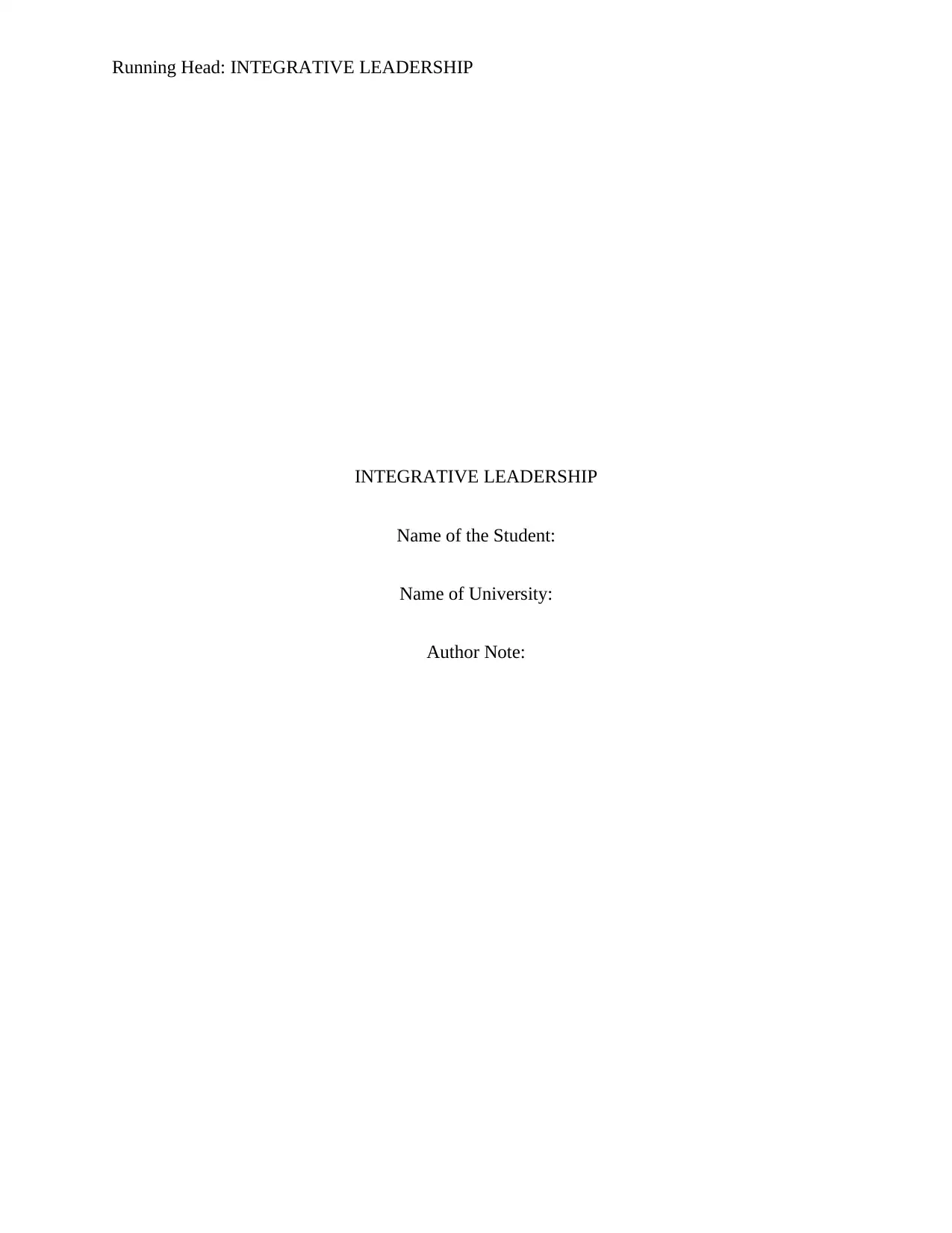
Running Head: INTEGRATIVE LEADERSHIP
INTEGRATIVE LEADERSHIP
Name of the Student:
Name of University:
Author Note:
INTEGRATIVE LEADERSHIP
Name of the Student:
Name of University:
Author Note:
Secure Best Marks with AI Grader
Need help grading? Try our AI Grader for instant feedback on your assignments.
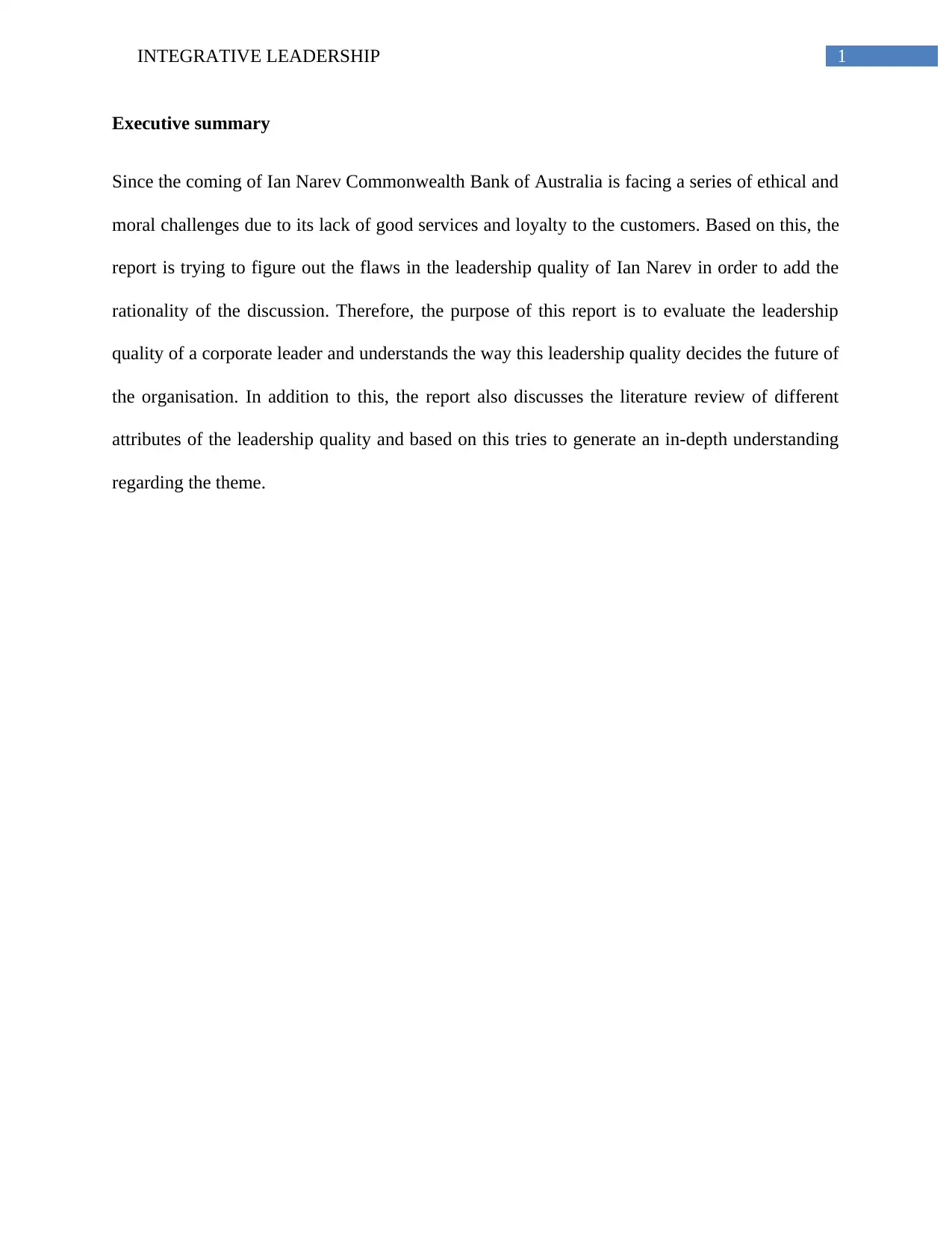
1INTEGRATIVE LEADERSHIP
Executive summary
Since the coming of Ian Narev Commonwealth Bank of Australia is facing a series of ethical and
moral challenges due to its lack of good services and loyalty to the customers. Based on this, the
report is trying to figure out the flaws in the leadership quality of Ian Narev in order to add the
rationality of the discussion. Therefore, the purpose of this report is to evaluate the leadership
quality of a corporate leader and understands the way this leadership quality decides the future of
the organisation. In addition to this, the report also discusses the literature review of different
attributes of the leadership quality and based on this tries to generate an in-depth understanding
regarding the theme.
Executive summary
Since the coming of Ian Narev Commonwealth Bank of Australia is facing a series of ethical and
moral challenges due to its lack of good services and loyalty to the customers. Based on this, the
report is trying to figure out the flaws in the leadership quality of Ian Narev in order to add the
rationality of the discussion. Therefore, the purpose of this report is to evaluate the leadership
quality of a corporate leader and understands the way this leadership quality decides the future of
the organisation. In addition to this, the report also discusses the literature review of different
attributes of the leadership quality and based on this tries to generate an in-depth understanding
regarding the theme.
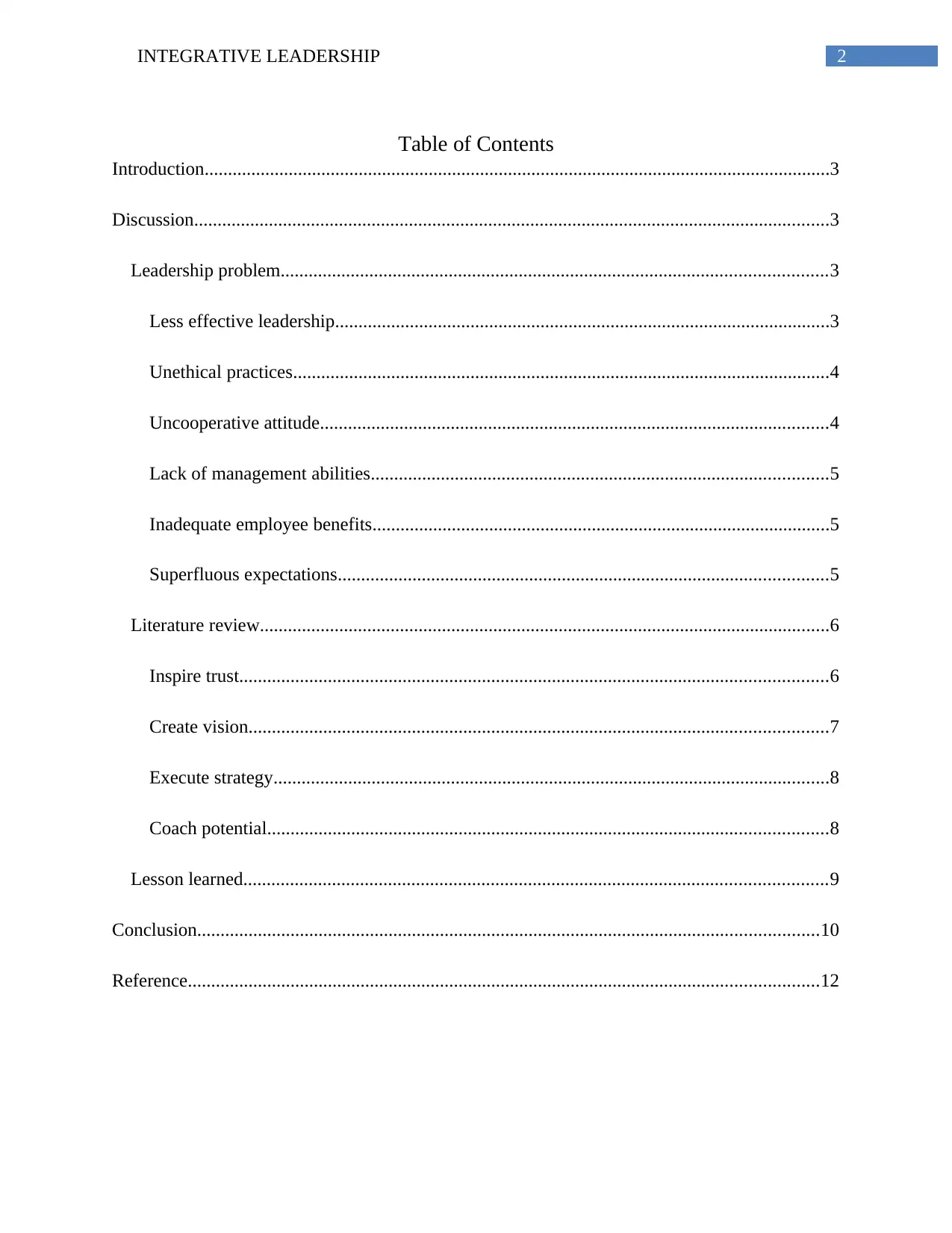
2INTEGRATIVE LEADERSHIP
Table of Contents
Introduction......................................................................................................................................3
Discussion........................................................................................................................................3
Leadership problem.....................................................................................................................3
Less effective leadership..........................................................................................................3
Unethical practices...................................................................................................................4
Uncooperative attitude.............................................................................................................4
Lack of management abilities..................................................................................................5
Inadequate employee benefits..................................................................................................5
Superfluous expectations.........................................................................................................5
Literature review..........................................................................................................................6
Inspire trust..............................................................................................................................6
Create vision............................................................................................................................7
Execute strategy.......................................................................................................................8
Coach potential........................................................................................................................8
Lesson learned.............................................................................................................................9
Conclusion.....................................................................................................................................10
Reference.......................................................................................................................................12
Table of Contents
Introduction......................................................................................................................................3
Discussion........................................................................................................................................3
Leadership problem.....................................................................................................................3
Less effective leadership..........................................................................................................3
Unethical practices...................................................................................................................4
Uncooperative attitude.............................................................................................................4
Lack of management abilities..................................................................................................5
Inadequate employee benefits..................................................................................................5
Superfluous expectations.........................................................................................................5
Literature review..........................................................................................................................6
Inspire trust..............................................................................................................................6
Create vision............................................................................................................................7
Execute strategy.......................................................................................................................8
Coach potential........................................................................................................................8
Lesson learned.............................................................................................................................9
Conclusion.....................................................................................................................................10
Reference.......................................................................................................................................12
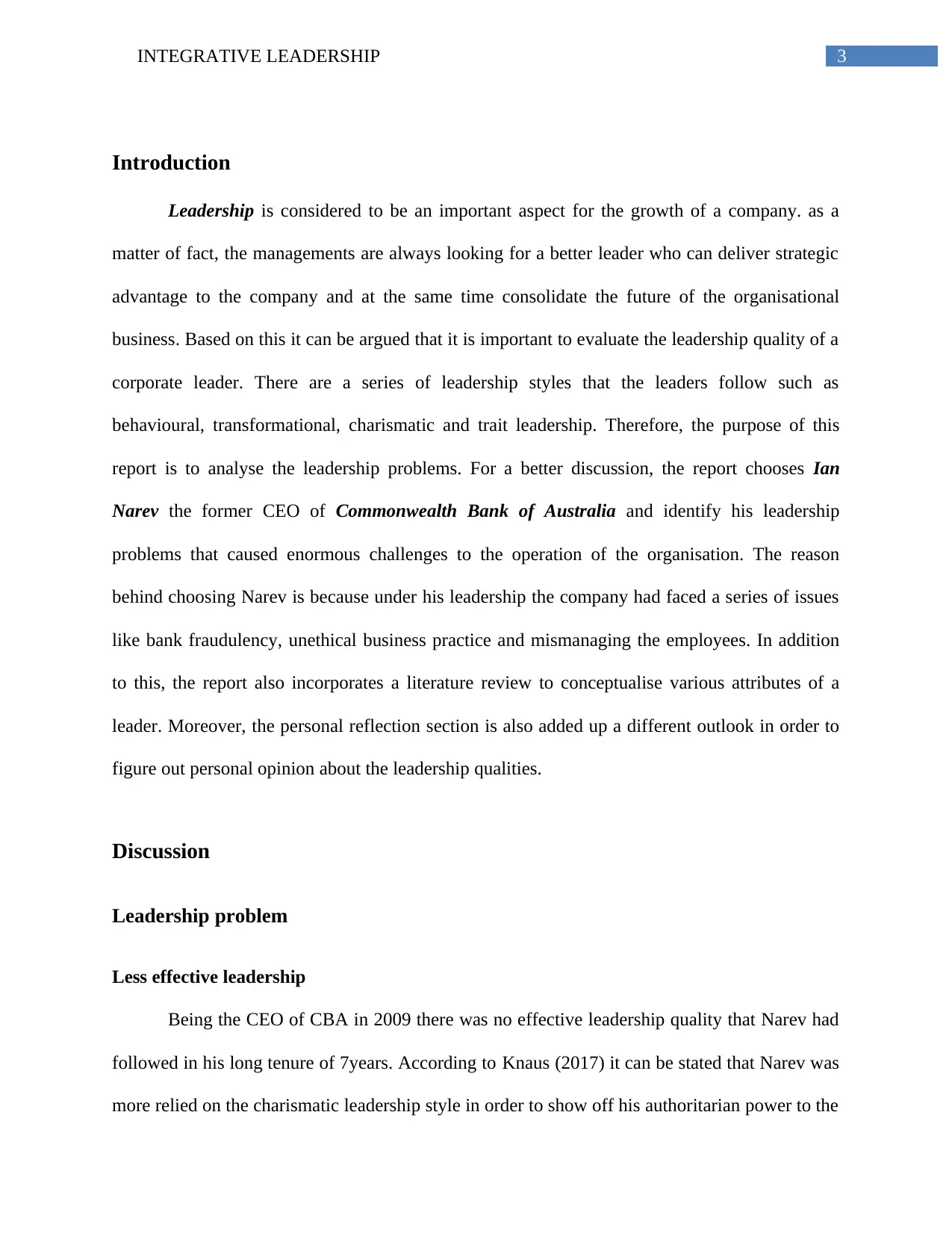
3INTEGRATIVE LEADERSHIP
Introduction
Leadership is considered to be an important aspect for the growth of a company. as a
matter of fact, the managements are always looking for a better leader who can deliver strategic
advantage to the company and at the same time consolidate the future of the organisational
business. Based on this it can be argued that it is important to evaluate the leadership quality of a
corporate leader. There are a series of leadership styles that the leaders follow such as
behavioural, transformational, charismatic and trait leadership. Therefore, the purpose of this
report is to analyse the leadership problems. For a better discussion, the report chooses Ian
Narev the former CEO of Commonwealth Bank of Australia and identify his leadership
problems that caused enormous challenges to the operation of the organisation. The reason
behind choosing Narev is because under his leadership the company had faced a series of issues
like bank fraudulency, unethical business practice and mismanaging the employees. In addition
to this, the report also incorporates a literature review to conceptualise various attributes of a
leader. Moreover, the personal reflection section is also added up a different outlook in order to
figure out personal opinion about the leadership qualities.
Discussion
Leadership problem
Less effective leadership
Being the CEO of CBA in 2009 there was no effective leadership quality that Narev had
followed in his long tenure of 7years. According to Knaus (2017) it can be stated that Narev was
more relied on the charismatic leadership style in order to show off his authoritarian power to the
Introduction
Leadership is considered to be an important aspect for the growth of a company. as a
matter of fact, the managements are always looking for a better leader who can deliver strategic
advantage to the company and at the same time consolidate the future of the organisational
business. Based on this it can be argued that it is important to evaluate the leadership quality of a
corporate leader. There are a series of leadership styles that the leaders follow such as
behavioural, transformational, charismatic and trait leadership. Therefore, the purpose of this
report is to analyse the leadership problems. For a better discussion, the report chooses Ian
Narev the former CEO of Commonwealth Bank of Australia and identify his leadership
problems that caused enormous challenges to the operation of the organisation. The reason
behind choosing Narev is because under his leadership the company had faced a series of issues
like bank fraudulency, unethical business practice and mismanaging the employees. In addition
to this, the report also incorporates a literature review to conceptualise various attributes of a
leader. Moreover, the personal reflection section is also added up a different outlook in order to
figure out personal opinion about the leadership qualities.
Discussion
Leadership problem
Less effective leadership
Being the CEO of CBA in 2009 there was no effective leadership quality that Narev had
followed in his long tenure of 7years. According to Knaus (2017) it can be stated that Narev was
more relied on the charismatic leadership style in order to show off his authoritarian power to the
Secure Best Marks with AI Grader
Need help grading? Try our AI Grader for instant feedback on your assignments.
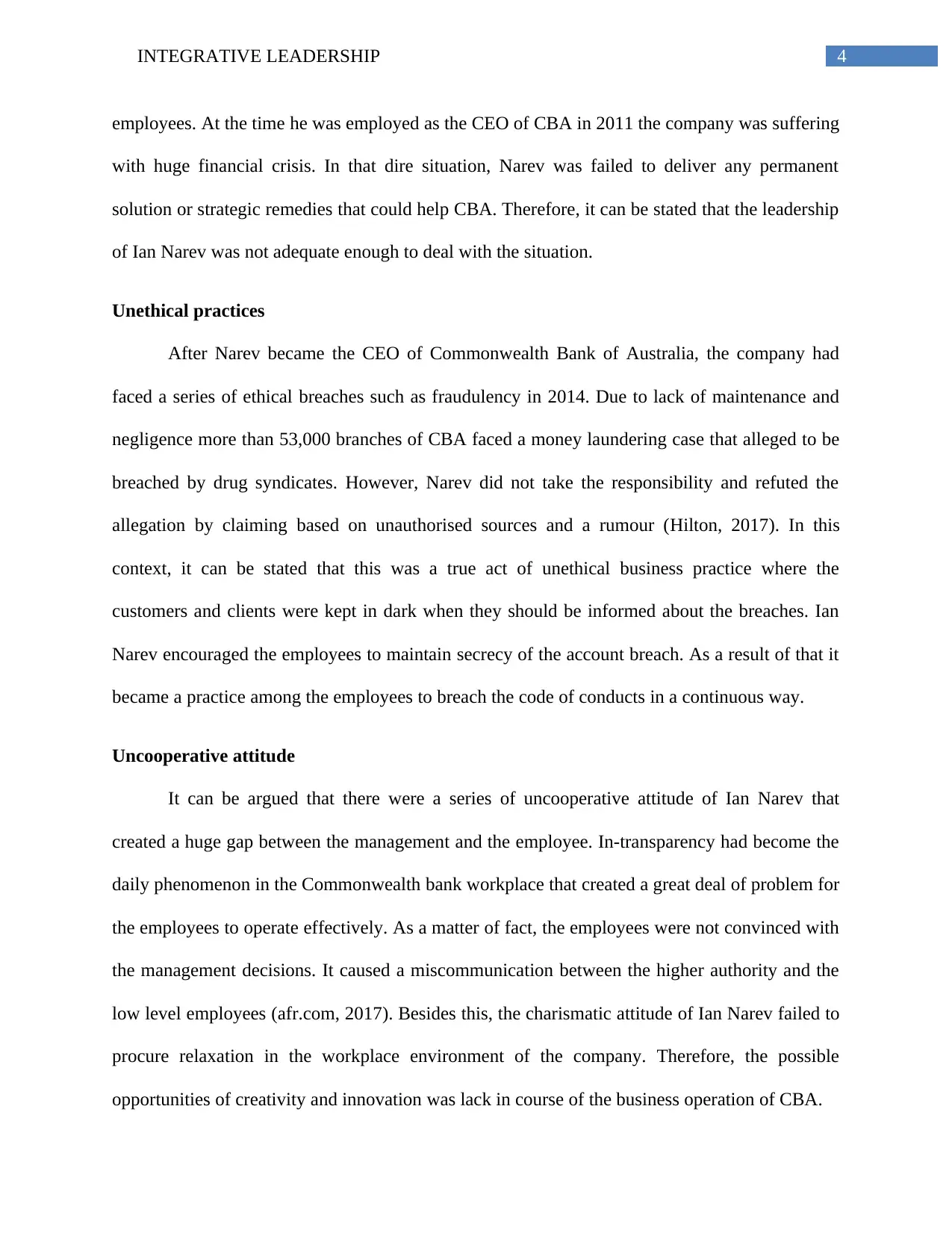
4INTEGRATIVE LEADERSHIP
employees. At the time he was employed as the CEO of CBA in 2011 the company was suffering
with huge financial crisis. In that dire situation, Narev was failed to deliver any permanent
solution or strategic remedies that could help CBA. Therefore, it can be stated that the leadership
of Ian Narev was not adequate enough to deal with the situation.
Unethical practices
After Narev became the CEO of Commonwealth Bank of Australia, the company had
faced a series of ethical breaches such as fraudulency in 2014. Due to lack of maintenance and
negligence more than 53,000 branches of CBA faced a money laundering case that alleged to be
breached by drug syndicates. However, Narev did not take the responsibility and refuted the
allegation by claiming based on unauthorised sources and a rumour (Hilton, 2017). In this
context, it can be stated that this was a true act of unethical business practice where the
customers and clients were kept in dark when they should be informed about the breaches. Ian
Narev encouraged the employees to maintain secrecy of the account breach. As a result of that it
became a practice among the employees to breach the code of conducts in a continuous way.
Uncooperative attitude
It can be argued that there were a series of uncooperative attitude of Ian Narev that
created a huge gap between the management and the employee. In-transparency had become the
daily phenomenon in the Commonwealth bank workplace that created a great deal of problem for
the employees to operate effectively. As a matter of fact, the employees were not convinced with
the management decisions. It caused a miscommunication between the higher authority and the
low level employees (afr.com, 2017). Besides this, the charismatic attitude of Ian Narev failed to
procure relaxation in the workplace environment of the company. Therefore, the possible
opportunities of creativity and innovation was lack in course of the business operation of CBA.
employees. At the time he was employed as the CEO of CBA in 2011 the company was suffering
with huge financial crisis. In that dire situation, Narev was failed to deliver any permanent
solution or strategic remedies that could help CBA. Therefore, it can be stated that the leadership
of Ian Narev was not adequate enough to deal with the situation.
Unethical practices
After Narev became the CEO of Commonwealth Bank of Australia, the company had
faced a series of ethical breaches such as fraudulency in 2014. Due to lack of maintenance and
negligence more than 53,000 branches of CBA faced a money laundering case that alleged to be
breached by drug syndicates. However, Narev did not take the responsibility and refuted the
allegation by claiming based on unauthorised sources and a rumour (Hilton, 2017). In this
context, it can be stated that this was a true act of unethical business practice where the
customers and clients were kept in dark when they should be informed about the breaches. Ian
Narev encouraged the employees to maintain secrecy of the account breach. As a result of that it
became a practice among the employees to breach the code of conducts in a continuous way.
Uncooperative attitude
It can be argued that there were a series of uncooperative attitude of Ian Narev that
created a huge gap between the management and the employee. In-transparency had become the
daily phenomenon in the Commonwealth bank workplace that created a great deal of problem for
the employees to operate effectively. As a matter of fact, the employees were not convinced with
the management decisions. It caused a miscommunication between the higher authority and the
low level employees (afr.com, 2017). Besides this, the charismatic attitude of Ian Narev failed to
procure relaxation in the workplace environment of the company. Therefore, the possible
opportunities of creativity and innovation was lack in course of the business operation of CBA.
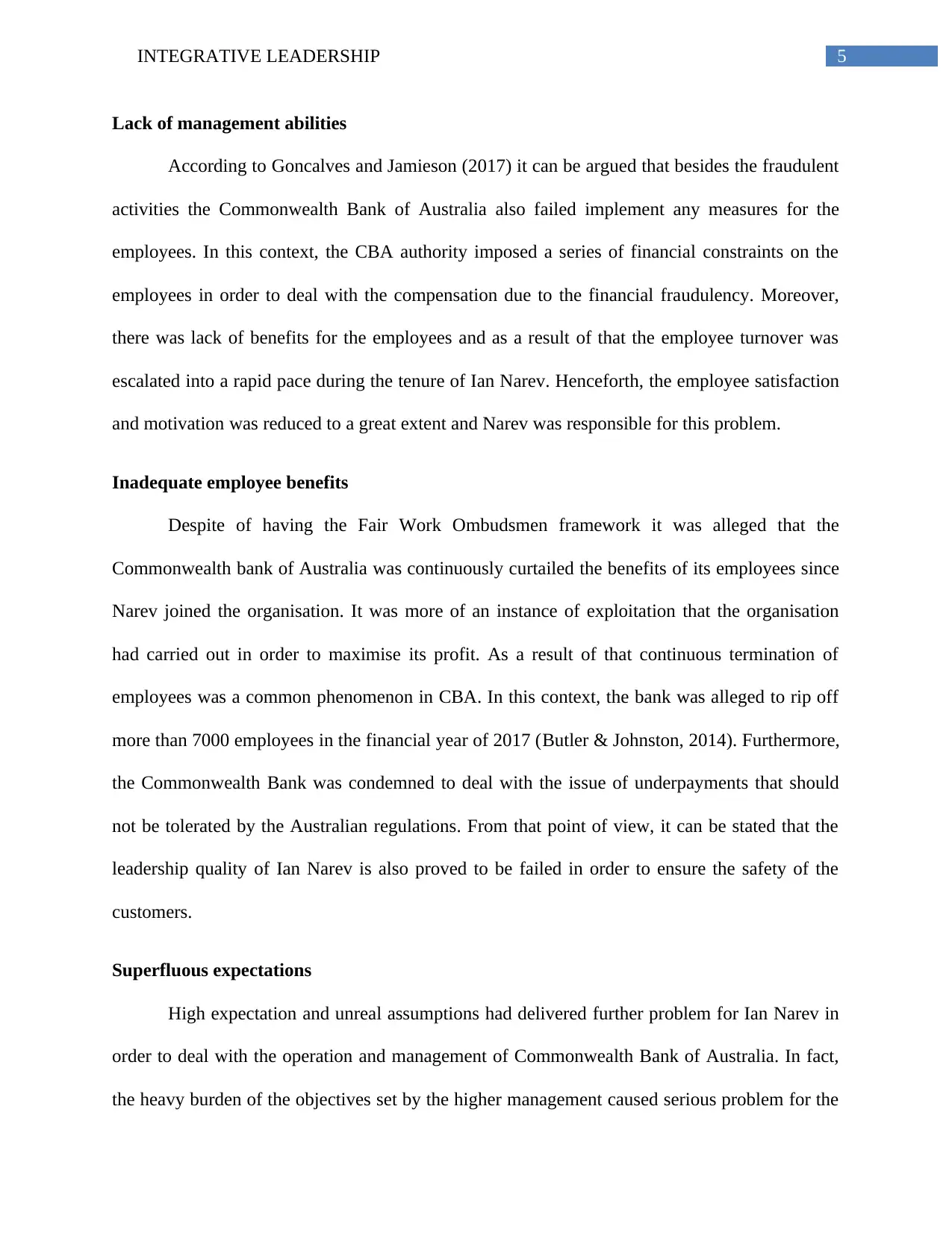
5INTEGRATIVE LEADERSHIP
Lack of management abilities
According to Goncalves and Jamieson (2017) it can be argued that besides the fraudulent
activities the Commonwealth Bank of Australia also failed implement any measures for the
employees. In this context, the CBA authority imposed a series of financial constraints on the
employees in order to deal with the compensation due to the financial fraudulency. Moreover,
there was lack of benefits for the employees and as a result of that the employee turnover was
escalated into a rapid pace during the tenure of Ian Narev. Henceforth, the employee satisfaction
and motivation was reduced to a great extent and Narev was responsible for this problem.
Inadequate employee benefits
Despite of having the Fair Work Ombudsmen framework it was alleged that the
Commonwealth bank of Australia was continuously curtailed the benefits of its employees since
Narev joined the organisation. It was more of an instance of exploitation that the organisation
had carried out in order to maximise its profit. As a result of that continuous termination of
employees was a common phenomenon in CBA. In this context, the bank was alleged to rip off
more than 7000 employees in the financial year of 2017 (Butler & Johnston, 2014). Furthermore,
the Commonwealth Bank was condemned to deal with the issue of underpayments that should
not be tolerated by the Australian regulations. From that point of view, it can be stated that the
leadership quality of Ian Narev is also proved to be failed in order to ensure the safety of the
customers.
Superfluous expectations
High expectation and unreal assumptions had delivered further problem for Ian Narev in
order to deal with the operation and management of Commonwealth Bank of Australia. In fact,
the heavy burden of the objectives set by the higher management caused serious problem for the
Lack of management abilities
According to Goncalves and Jamieson (2017) it can be argued that besides the fraudulent
activities the Commonwealth Bank of Australia also failed implement any measures for the
employees. In this context, the CBA authority imposed a series of financial constraints on the
employees in order to deal with the compensation due to the financial fraudulency. Moreover,
there was lack of benefits for the employees and as a result of that the employee turnover was
escalated into a rapid pace during the tenure of Ian Narev. Henceforth, the employee satisfaction
and motivation was reduced to a great extent and Narev was responsible for this problem.
Inadequate employee benefits
Despite of having the Fair Work Ombudsmen framework it was alleged that the
Commonwealth bank of Australia was continuously curtailed the benefits of its employees since
Narev joined the organisation. It was more of an instance of exploitation that the organisation
had carried out in order to maximise its profit. As a result of that continuous termination of
employees was a common phenomenon in CBA. In this context, the bank was alleged to rip off
more than 7000 employees in the financial year of 2017 (Butler & Johnston, 2014). Furthermore,
the Commonwealth Bank was condemned to deal with the issue of underpayments that should
not be tolerated by the Australian regulations. From that point of view, it can be stated that the
leadership quality of Ian Narev is also proved to be failed in order to ensure the safety of the
customers.
Superfluous expectations
High expectation and unreal assumptions had delivered further problem for Ian Narev in
order to deal with the operation and management of Commonwealth Bank of Australia. In fact,
the heavy burden of the objectives set by the higher management caused serious problem for the
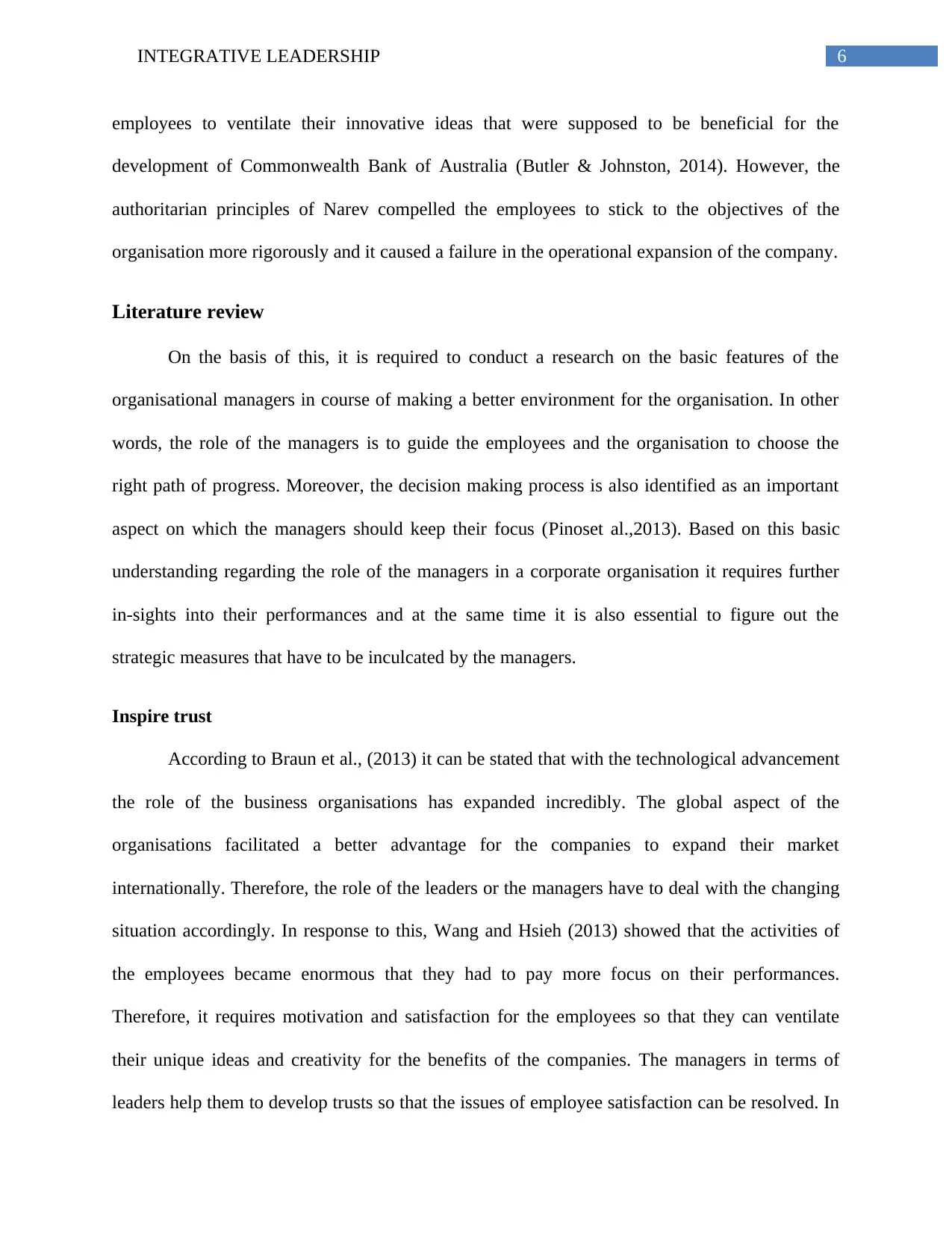
6INTEGRATIVE LEADERSHIP
employees to ventilate their innovative ideas that were supposed to be beneficial for the
development of Commonwealth Bank of Australia (Butler & Johnston, 2014). However, the
authoritarian principles of Narev compelled the employees to stick to the objectives of the
organisation more rigorously and it caused a failure in the operational expansion of the company.
Literature review
On the basis of this, it is required to conduct a research on the basic features of the
organisational managers in course of making a better environment for the organisation. In other
words, the role of the managers is to guide the employees and the organisation to choose the
right path of progress. Moreover, the decision making process is also identified as an important
aspect on which the managers should keep their focus (Pinoset al.,2013). Based on this basic
understanding regarding the role of the managers in a corporate organisation it requires further
in-sights into their performances and at the same time it is also essential to figure out the
strategic measures that have to be inculcated by the managers.
Inspire trust
According to Braun et al., (2013) it can be stated that with the technological advancement
the role of the business organisations has expanded incredibly. The global aspect of the
organisations facilitated a better advantage for the companies to expand their market
internationally. Therefore, the role of the leaders or the managers have to deal with the changing
situation accordingly. In response to this, Wang and Hsieh (2013) showed that the activities of
the employees became enormous that they had to pay more focus on their performances.
Therefore, it requires motivation and satisfaction for the employees so that they can ventilate
their unique ideas and creativity for the benefits of the companies. The managers in terms of
leaders help them to develop trusts so that the issues of employee satisfaction can be resolved. In
employees to ventilate their innovative ideas that were supposed to be beneficial for the
development of Commonwealth Bank of Australia (Butler & Johnston, 2014). However, the
authoritarian principles of Narev compelled the employees to stick to the objectives of the
organisation more rigorously and it caused a failure in the operational expansion of the company.
Literature review
On the basis of this, it is required to conduct a research on the basic features of the
organisational managers in course of making a better environment for the organisation. In other
words, the role of the managers is to guide the employees and the organisation to choose the
right path of progress. Moreover, the decision making process is also identified as an important
aspect on which the managers should keep their focus (Pinoset al.,2013). Based on this basic
understanding regarding the role of the managers in a corporate organisation it requires further
in-sights into their performances and at the same time it is also essential to figure out the
strategic measures that have to be inculcated by the managers.
Inspire trust
According to Braun et al., (2013) it can be stated that with the technological advancement
the role of the business organisations has expanded incredibly. The global aspect of the
organisations facilitated a better advantage for the companies to expand their market
internationally. Therefore, the role of the leaders or the managers have to deal with the changing
situation accordingly. In response to this, Wang and Hsieh (2013) showed that the activities of
the employees became enormous that they had to pay more focus on their performances.
Therefore, it requires motivation and satisfaction for the employees so that they can ventilate
their unique ideas and creativity for the benefits of the companies. The managers in terms of
leaders help them to develop trusts so that the issues of employee satisfaction can be resolved. In
Paraphrase This Document
Need a fresh take? Get an instant paraphrase of this document with our AI Paraphraser
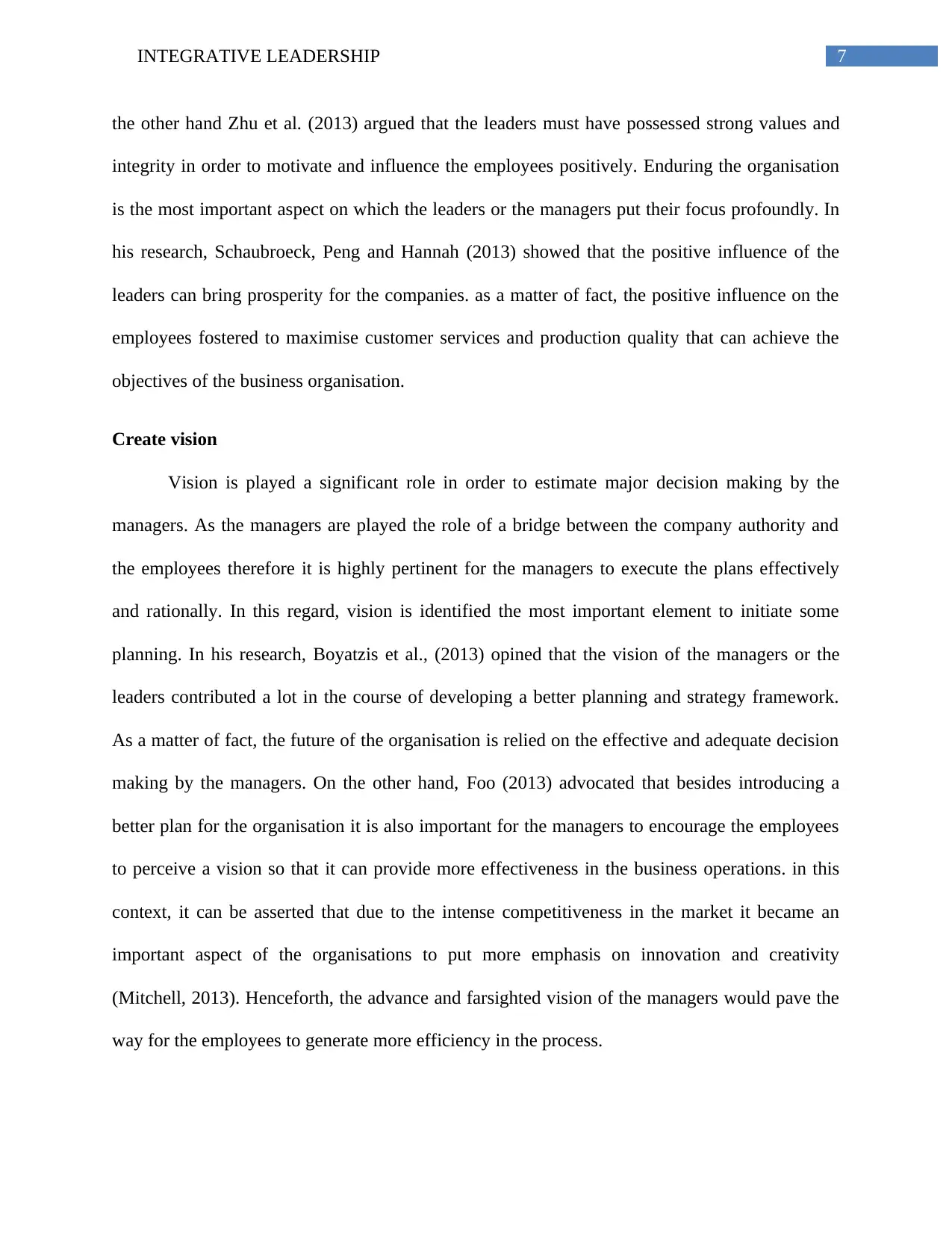
7INTEGRATIVE LEADERSHIP
the other hand Zhu et al. (2013) argued that the leaders must have possessed strong values and
integrity in order to motivate and influence the employees positively. Enduring the organisation
is the most important aspect on which the leaders or the managers put their focus profoundly. In
his research, Schaubroeck, Peng and Hannah (2013) showed that the positive influence of the
leaders can bring prosperity for the companies. as a matter of fact, the positive influence on the
employees fostered to maximise customer services and production quality that can achieve the
objectives of the business organisation.
Create vision
Vision is played a significant role in order to estimate major decision making by the
managers. As the managers are played the role of a bridge between the company authority and
the employees therefore it is highly pertinent for the managers to execute the plans effectively
and rationally. In this regard, vision is identified the most important element to initiate some
planning. In his research, Boyatzis et al., (2013) opined that the vision of the managers or the
leaders contributed a lot in the course of developing a better planning and strategy framework.
As a matter of fact, the future of the organisation is relied on the effective and adequate decision
making by the managers. On the other hand, Foo (2013) advocated that besides introducing a
better plan for the organisation it is also important for the managers to encourage the employees
to perceive a vision so that it can provide more effectiveness in the business operations. in this
context, it can be asserted that due to the intense competitiveness in the market it became an
important aspect of the organisations to put more emphasis on innovation and creativity
(Mitchell, 2013). Henceforth, the advance and farsighted vision of the managers would pave the
way for the employees to generate more efficiency in the process.
the other hand Zhu et al. (2013) argued that the leaders must have possessed strong values and
integrity in order to motivate and influence the employees positively. Enduring the organisation
is the most important aspect on which the leaders or the managers put their focus profoundly. In
his research, Schaubroeck, Peng and Hannah (2013) showed that the positive influence of the
leaders can bring prosperity for the companies. as a matter of fact, the positive influence on the
employees fostered to maximise customer services and production quality that can achieve the
objectives of the business organisation.
Create vision
Vision is played a significant role in order to estimate major decision making by the
managers. As the managers are played the role of a bridge between the company authority and
the employees therefore it is highly pertinent for the managers to execute the plans effectively
and rationally. In this regard, vision is identified the most important element to initiate some
planning. In his research, Boyatzis et al., (2013) opined that the vision of the managers or the
leaders contributed a lot in the course of developing a better planning and strategy framework.
As a matter of fact, the future of the organisation is relied on the effective and adequate decision
making by the managers. On the other hand, Foo (2013) advocated that besides introducing a
better plan for the organisation it is also important for the managers to encourage the employees
to perceive a vision so that it can provide more effectiveness in the business operations. in this
context, it can be asserted that due to the intense competitiveness in the market it became an
important aspect of the organisations to put more emphasis on innovation and creativity
(Mitchell, 2013). Henceforth, the advance and farsighted vision of the managers would pave the
way for the employees to generate more efficiency in the process.
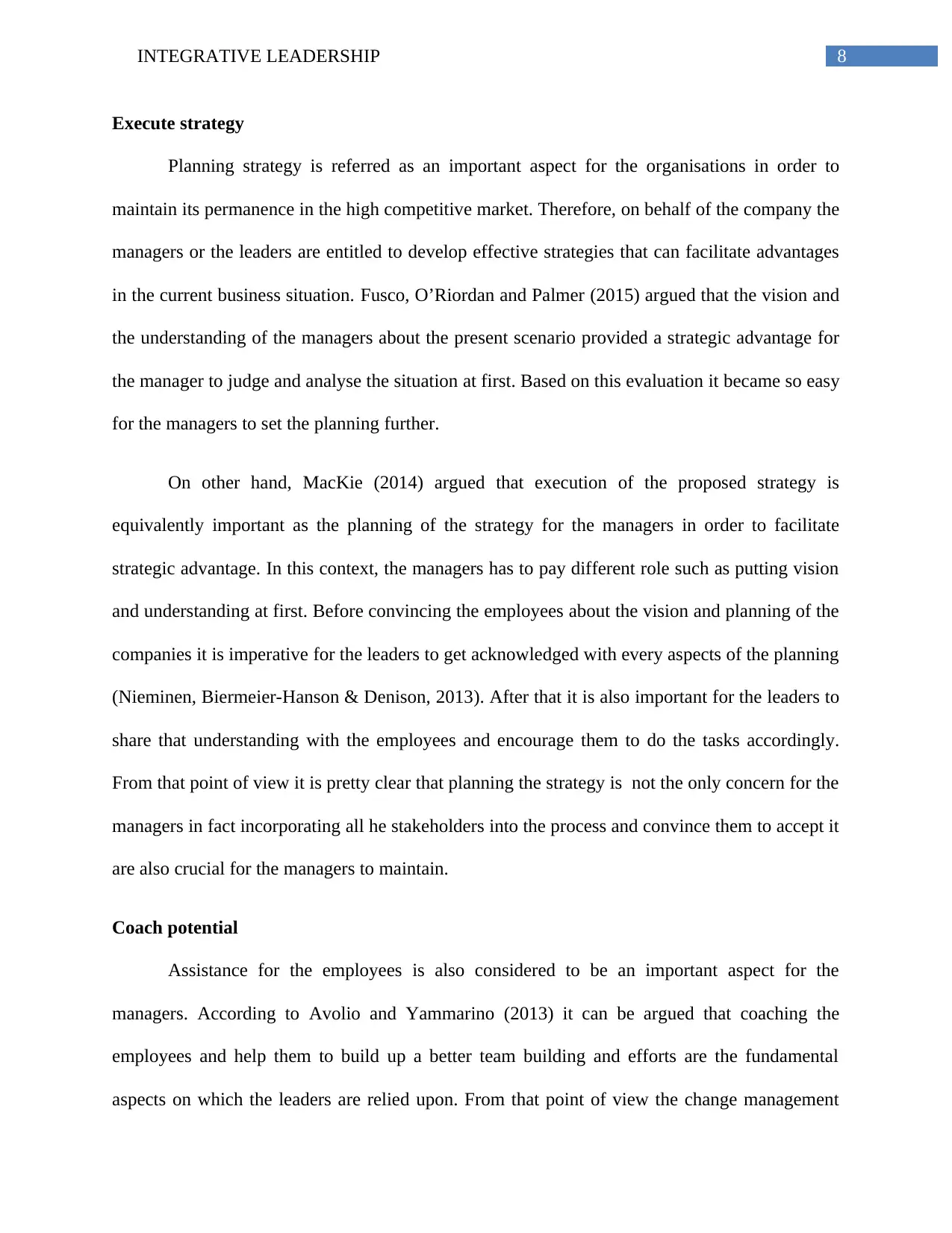
8INTEGRATIVE LEADERSHIP
Execute strategy
Planning strategy is referred as an important aspect for the organisations in order to
maintain its permanence in the high competitive market. Therefore, on behalf of the company the
managers or the leaders are entitled to develop effective strategies that can facilitate advantages
in the current business situation. Fusco, O’Riordan and Palmer (2015) argued that the vision and
the understanding of the managers about the present scenario provided a strategic advantage for
the manager to judge and analyse the situation at first. Based on this evaluation it became so easy
for the managers to set the planning further.
On other hand, MacKie (2014) argued that execution of the proposed strategy is
equivalently important as the planning of the strategy for the managers in order to facilitate
strategic advantage. In this context, the managers has to pay different role such as putting vision
and understanding at first. Before convincing the employees about the vision and planning of the
companies it is imperative for the leaders to get acknowledged with every aspects of the planning
(Nieminen, Biermeier-Hanson & Denison, 2013). After that it is also important for the leaders to
share that understanding with the employees and encourage them to do the tasks accordingly.
From that point of view it is pretty clear that planning the strategy is not the only concern for the
managers in fact incorporating all he stakeholders into the process and convince them to accept it
are also crucial for the managers to maintain.
Coach potential
Assistance for the employees is also considered to be an important aspect for the
managers. According to Avolio and Yammarino (2013) it can be argued that coaching the
employees and help them to build up a better team building and efforts are the fundamental
aspects on which the leaders are relied upon. From that point of view the change management
Execute strategy
Planning strategy is referred as an important aspect for the organisations in order to
maintain its permanence in the high competitive market. Therefore, on behalf of the company the
managers or the leaders are entitled to develop effective strategies that can facilitate advantages
in the current business situation. Fusco, O’Riordan and Palmer (2015) argued that the vision and
the understanding of the managers about the present scenario provided a strategic advantage for
the manager to judge and analyse the situation at first. Based on this evaluation it became so easy
for the managers to set the planning further.
On other hand, MacKie (2014) argued that execution of the proposed strategy is
equivalently important as the planning of the strategy for the managers in order to facilitate
strategic advantage. In this context, the managers has to pay different role such as putting vision
and understanding at first. Before convincing the employees about the vision and planning of the
companies it is imperative for the leaders to get acknowledged with every aspects of the planning
(Nieminen, Biermeier-Hanson & Denison, 2013). After that it is also important for the leaders to
share that understanding with the employees and encourage them to do the tasks accordingly.
From that point of view it is pretty clear that planning the strategy is not the only concern for the
managers in fact incorporating all he stakeholders into the process and convince them to accept it
are also crucial for the managers to maintain.
Coach potential
Assistance for the employees is also considered to be an important aspect for the
managers. According to Avolio and Yammarino (2013) it can be argued that coaching the
employees and help them to build up a better team building and efforts are the fundamental
aspects on which the leaders are relied upon. From that point of view the change management
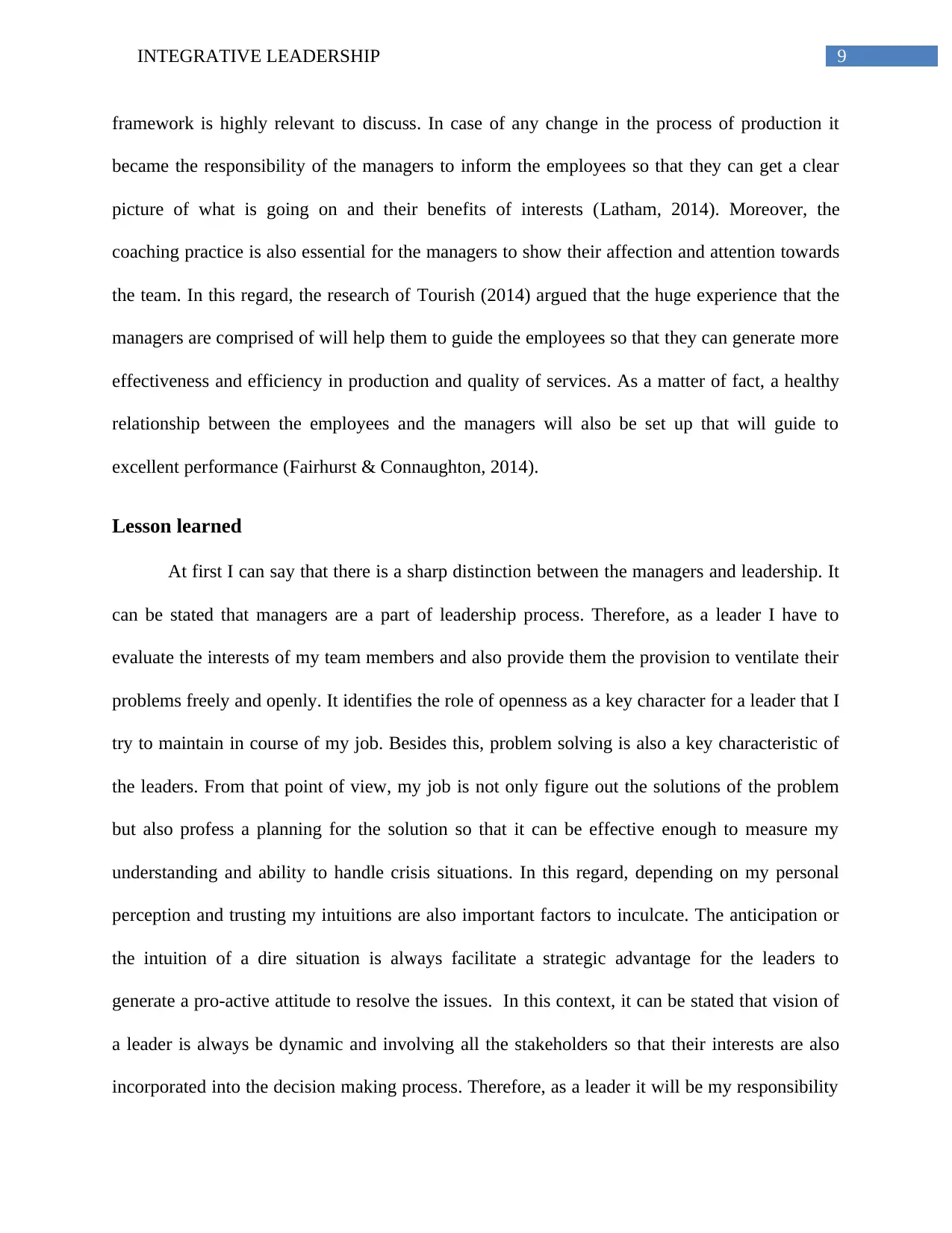
9INTEGRATIVE LEADERSHIP
framework is highly relevant to discuss. In case of any change in the process of production it
became the responsibility of the managers to inform the employees so that they can get a clear
picture of what is going on and their benefits of interests (Latham, 2014). Moreover, the
coaching practice is also essential for the managers to show their affection and attention towards
the team. In this regard, the research of Tourish (2014) argued that the huge experience that the
managers are comprised of will help them to guide the employees so that they can generate more
effectiveness and efficiency in production and quality of services. As a matter of fact, a healthy
relationship between the employees and the managers will also be set up that will guide to
excellent performance (Fairhurst & Connaughton, 2014).
Lesson learned
At first I can say that there is a sharp distinction between the managers and leadership. It
can be stated that managers are a part of leadership process. Therefore, as a leader I have to
evaluate the interests of my team members and also provide them the provision to ventilate their
problems freely and openly. It identifies the role of openness as a key character for a leader that I
try to maintain in course of my job. Besides this, problem solving is also a key characteristic of
the leaders. From that point of view, my job is not only figure out the solutions of the problem
but also profess a planning for the solution so that it can be effective enough to measure my
understanding and ability to handle crisis situations. In this regard, depending on my personal
perception and trusting my intuitions are also important factors to inculcate. The anticipation or
the intuition of a dire situation is always facilitate a strategic advantage for the leaders to
generate a pro-active attitude to resolve the issues. In this context, it can be stated that vision of
a leader is always be dynamic and involving all the stakeholders so that their interests are also
incorporated into the decision making process. Therefore, as a leader it will be my responsibility
framework is highly relevant to discuss. In case of any change in the process of production it
became the responsibility of the managers to inform the employees so that they can get a clear
picture of what is going on and their benefits of interests (Latham, 2014). Moreover, the
coaching practice is also essential for the managers to show their affection and attention towards
the team. In this regard, the research of Tourish (2014) argued that the huge experience that the
managers are comprised of will help them to guide the employees so that they can generate more
effectiveness and efficiency in production and quality of services. As a matter of fact, a healthy
relationship between the employees and the managers will also be set up that will guide to
excellent performance (Fairhurst & Connaughton, 2014).
Lesson learned
At first I can say that there is a sharp distinction between the managers and leadership. It
can be stated that managers are a part of leadership process. Therefore, as a leader I have to
evaluate the interests of my team members and also provide them the provision to ventilate their
problems freely and openly. It identifies the role of openness as a key character for a leader that I
try to maintain in course of my job. Besides this, problem solving is also a key characteristic of
the leaders. From that point of view, my job is not only figure out the solutions of the problem
but also profess a planning for the solution so that it can be effective enough to measure my
understanding and ability to handle crisis situations. In this regard, depending on my personal
perception and trusting my intuitions are also important factors to inculcate. The anticipation or
the intuition of a dire situation is always facilitate a strategic advantage for the leaders to
generate a pro-active attitude to resolve the issues. In this context, it can be stated that vision of
a leader is always be dynamic and involving all the stakeholders so that their interests are also
incorporated into the decision making process. Therefore, as a leader it will be my responsibility
Secure Best Marks with AI Grader
Need help grading? Try our AI Grader for instant feedback on your assignments.
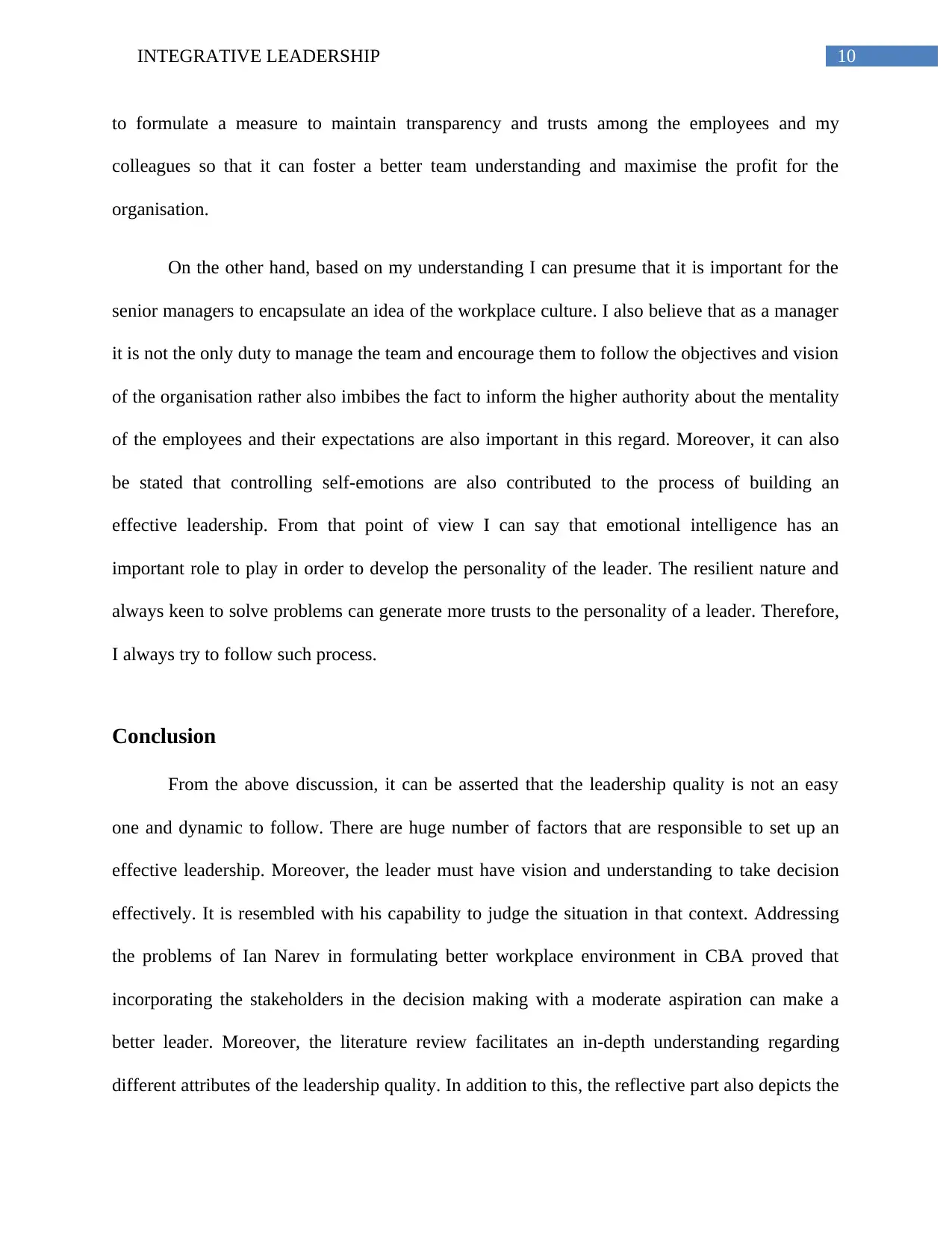
10INTEGRATIVE LEADERSHIP
to formulate a measure to maintain transparency and trusts among the employees and my
colleagues so that it can foster a better team understanding and maximise the profit for the
organisation.
On the other hand, based on my understanding I can presume that it is important for the
senior managers to encapsulate an idea of the workplace culture. I also believe that as a manager
it is not the only duty to manage the team and encourage them to follow the objectives and vision
of the organisation rather also imbibes the fact to inform the higher authority about the mentality
of the employees and their expectations are also important in this regard. Moreover, it can also
be stated that controlling self-emotions are also contributed to the process of building an
effective leadership. From that point of view I can say that emotional intelligence has an
important role to play in order to develop the personality of the leader. The resilient nature and
always keen to solve problems can generate more trusts to the personality of a leader. Therefore,
I always try to follow such process.
Conclusion
From the above discussion, it can be asserted that the leadership quality is not an easy
one and dynamic to follow. There are huge number of factors that are responsible to set up an
effective leadership. Moreover, the leader must have vision and understanding to take decision
effectively. It is resembled with his capability to judge the situation in that context. Addressing
the problems of Ian Narev in formulating better workplace environment in CBA proved that
incorporating the stakeholders in the decision making with a moderate aspiration can make a
better leader. Moreover, the literature review facilitates an in-depth understanding regarding
different attributes of the leadership quality. In addition to this, the reflective part also depicts the
to formulate a measure to maintain transparency and trusts among the employees and my
colleagues so that it can foster a better team understanding and maximise the profit for the
organisation.
On the other hand, based on my understanding I can presume that it is important for the
senior managers to encapsulate an idea of the workplace culture. I also believe that as a manager
it is not the only duty to manage the team and encourage them to follow the objectives and vision
of the organisation rather also imbibes the fact to inform the higher authority about the mentality
of the employees and their expectations are also important in this regard. Moreover, it can also
be stated that controlling self-emotions are also contributed to the process of building an
effective leadership. From that point of view I can say that emotional intelligence has an
important role to play in order to develop the personality of the leader. The resilient nature and
always keen to solve problems can generate more trusts to the personality of a leader. Therefore,
I always try to follow such process.
Conclusion
From the above discussion, it can be asserted that the leadership quality is not an easy
one and dynamic to follow. There are huge number of factors that are responsible to set up an
effective leadership. Moreover, the leader must have vision and understanding to take decision
effectively. It is resembled with his capability to judge the situation in that context. Addressing
the problems of Ian Narev in formulating better workplace environment in CBA proved that
incorporating the stakeholders in the decision making with a moderate aspiration can make a
better leader. Moreover, the literature review facilitates an in-depth understanding regarding
different attributes of the leadership quality. In addition to this, the reflective part also depicts the
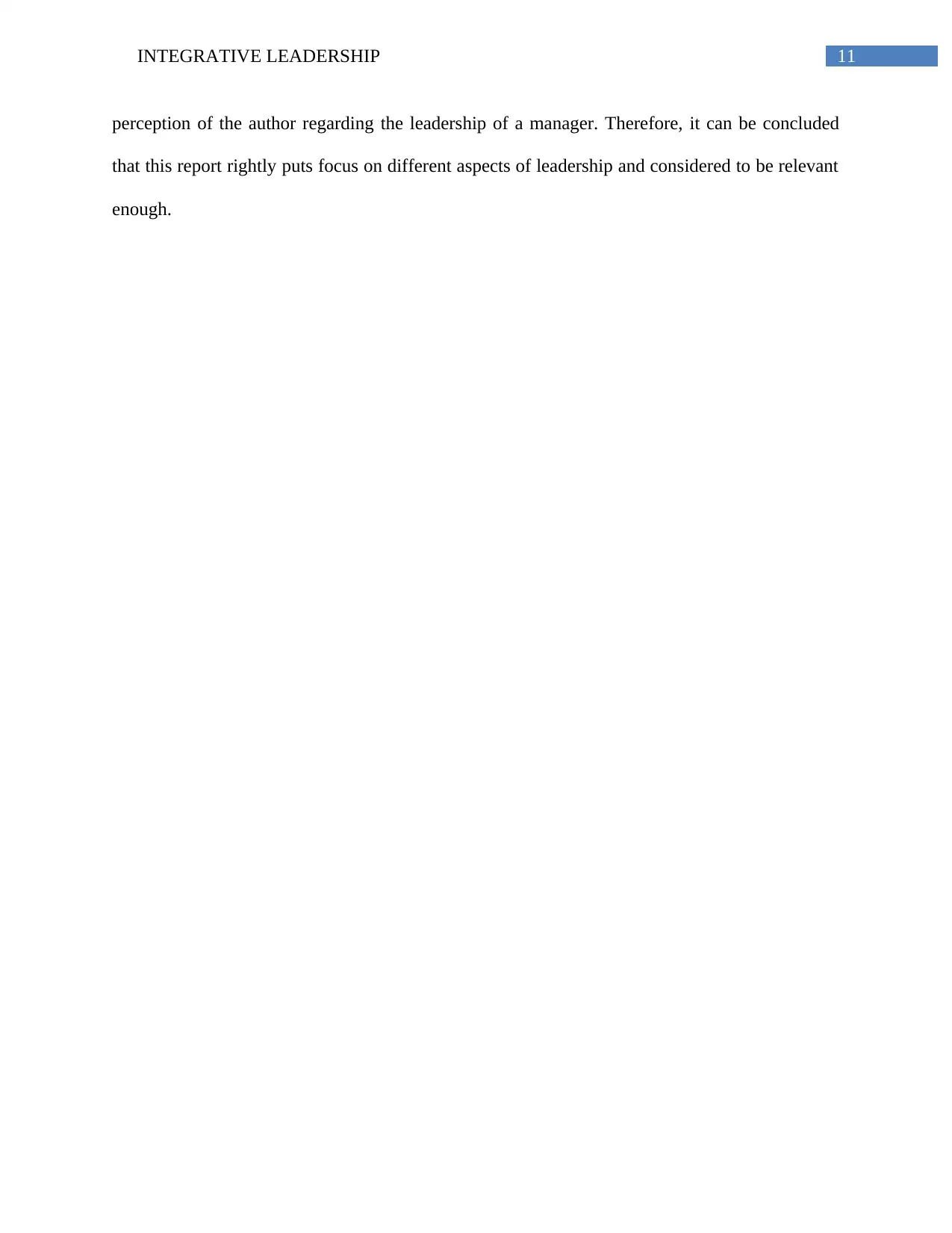
11INTEGRATIVE LEADERSHIP
perception of the author regarding the leadership of a manager. Therefore, it can be concluded
that this report rightly puts focus on different aspects of leadership and considered to be relevant
enough.
perception of the author regarding the leadership of a manager. Therefore, it can be concluded
that this report rightly puts focus on different aspects of leadership and considered to be relevant
enough.
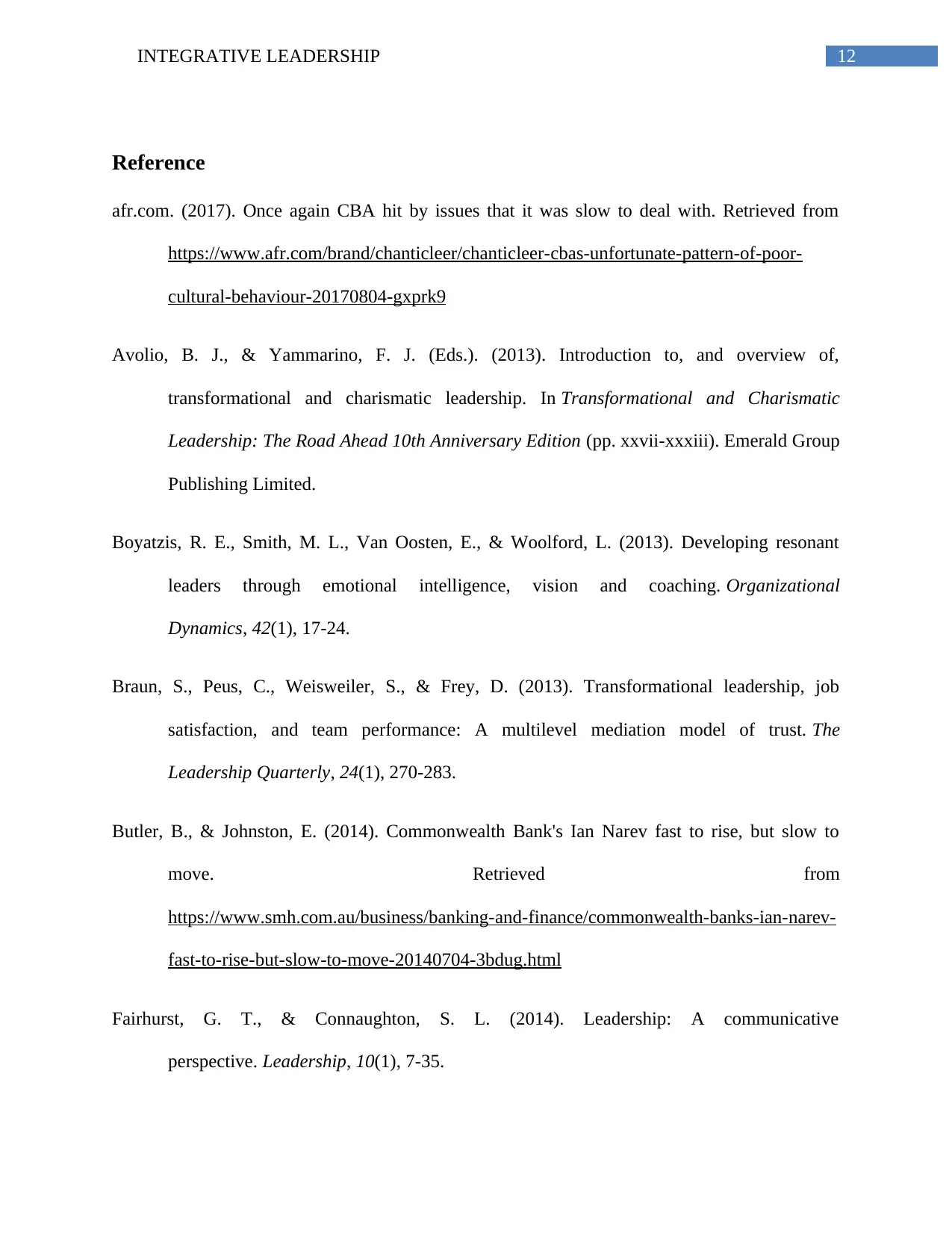
12INTEGRATIVE LEADERSHIP
Reference
afr.com. (2017). Once again CBA hit by issues that it was slow to deal with. Retrieved from
https://www.afr.com/brand/chanticleer/chanticleer-cbas-unfortunate-pattern-of-poor-
cultural-behaviour-20170804-gxprk9
Avolio, B. J., & Yammarino, F. J. (Eds.). (2013). Introduction to, and overview of,
transformational and charismatic leadership. In Transformational and Charismatic
Leadership: The Road Ahead 10th Anniversary Edition (pp. xxvii-xxxiii). Emerald Group
Publishing Limited.
Boyatzis, R. E., Smith, M. L., Van Oosten, E., & Woolford, L. (2013). Developing resonant
leaders through emotional intelligence, vision and coaching. Organizational
Dynamics, 42(1), 17-24.
Braun, S., Peus, C., Weisweiler, S., & Frey, D. (2013). Transformational leadership, job
satisfaction, and team performance: A multilevel mediation model of trust. The
Leadership Quarterly, 24(1), 270-283.
Butler, B., & Johnston, E. (2014). Commonwealth Bank's Ian Narev fast to rise, but slow to
move. Retrieved from
https://www.smh.com.au/business/banking-and-finance/commonwealth-banks-ian-narev-
fast-to-rise-but-slow-to-move-20140704-3bdug.html
Fairhurst, G. T., & Connaughton, S. L. (2014). Leadership: A communicative
perspective. Leadership, 10(1), 7-35.
Reference
afr.com. (2017). Once again CBA hit by issues that it was slow to deal with. Retrieved from
https://www.afr.com/brand/chanticleer/chanticleer-cbas-unfortunate-pattern-of-poor-
cultural-behaviour-20170804-gxprk9
Avolio, B. J., & Yammarino, F. J. (Eds.). (2013). Introduction to, and overview of,
transformational and charismatic leadership. In Transformational and Charismatic
Leadership: The Road Ahead 10th Anniversary Edition (pp. xxvii-xxxiii). Emerald Group
Publishing Limited.
Boyatzis, R. E., Smith, M. L., Van Oosten, E., & Woolford, L. (2013). Developing resonant
leaders through emotional intelligence, vision and coaching. Organizational
Dynamics, 42(1), 17-24.
Braun, S., Peus, C., Weisweiler, S., & Frey, D. (2013). Transformational leadership, job
satisfaction, and team performance: A multilevel mediation model of trust. The
Leadership Quarterly, 24(1), 270-283.
Butler, B., & Johnston, E. (2014). Commonwealth Bank's Ian Narev fast to rise, but slow to
move. Retrieved from
https://www.smh.com.au/business/banking-and-finance/commonwealth-banks-ian-narev-
fast-to-rise-but-slow-to-move-20140704-3bdug.html
Fairhurst, G. T., & Connaughton, S. L. (2014). Leadership: A communicative
perspective. Leadership, 10(1), 7-35.
Paraphrase This Document
Need a fresh take? Get an instant paraphrase of this document with our AI Paraphraser

13INTEGRATIVE LEADERSHIP
Foo, K. Y. (2013). A vision on the role of environmental higher education contributing to the
sustainable development in Malaysia. Journal of Cleaner Production, 61, 6-12.
Fusco, T., O’Riordan, S., & Palmer, S. (2015). Authentic leaders are… Conscious, Competent,
Confident, and Congruent: A grounded theory of group coaching and authentic leadership
development. International Coaching Psychology Review, 10(2), 131-148.
Goncalves, R., & Jamieson, M. (2017). Commonwealth Bank announces leadership changes.
Retrieved from https://www.sbs.com.au/news/commonwealth-bank-announces-
leadership-changes
Hilton, J. (2017). Commonwealth Bank allegedly ‘ripped off’ 7,000 employees, claims union.
Retrieved from https://www.hcamag.com/hr-news/commonwealth-bank-allegedly-
ripped-off-7000-employees-claims-union-231657.aspx
Knaus, C. (2017). Commonwealth Bank accused of money laundering and terrorism-financing
breaches. Retrieved from
https://www.theguardian.com/australia-news/2017/aug/03/commonwealth-bank-accused-
of-money-laundering-and-terrorism-financing-breaches
Latham, J. R. (2014). Leadership for quality and innovation: Challenges, theories, and a
framework for future research. Quality Management Journal, 21(1), 11-15.
MacKie, D. (2014). The effectiveness of strength-based executive coaching in enhancing full
range leadership development: A controlled study. Consulting Psychology Journal:
Practice and Research, 66(2), 118.
Foo, K. Y. (2013). A vision on the role of environmental higher education contributing to the
sustainable development in Malaysia. Journal of Cleaner Production, 61, 6-12.
Fusco, T., O’Riordan, S., & Palmer, S. (2015). Authentic leaders are… Conscious, Competent,
Confident, and Congruent: A grounded theory of group coaching and authentic leadership
development. International Coaching Psychology Review, 10(2), 131-148.
Goncalves, R., & Jamieson, M. (2017). Commonwealth Bank announces leadership changes.
Retrieved from https://www.sbs.com.au/news/commonwealth-bank-announces-
leadership-changes
Hilton, J. (2017). Commonwealth Bank allegedly ‘ripped off’ 7,000 employees, claims union.
Retrieved from https://www.hcamag.com/hr-news/commonwealth-bank-allegedly-
ripped-off-7000-employees-claims-union-231657.aspx
Knaus, C. (2017). Commonwealth Bank accused of money laundering and terrorism-financing
breaches. Retrieved from
https://www.theguardian.com/australia-news/2017/aug/03/commonwealth-bank-accused-
of-money-laundering-and-terrorism-financing-breaches
Latham, J. R. (2014). Leadership for quality and innovation: Challenges, theories, and a
framework for future research. Quality Management Journal, 21(1), 11-15.
MacKie, D. (2014). The effectiveness of strength-based executive coaching in enhancing full
range leadership development: A controlled study. Consulting Psychology Journal:
Practice and Research, 66(2), 118.
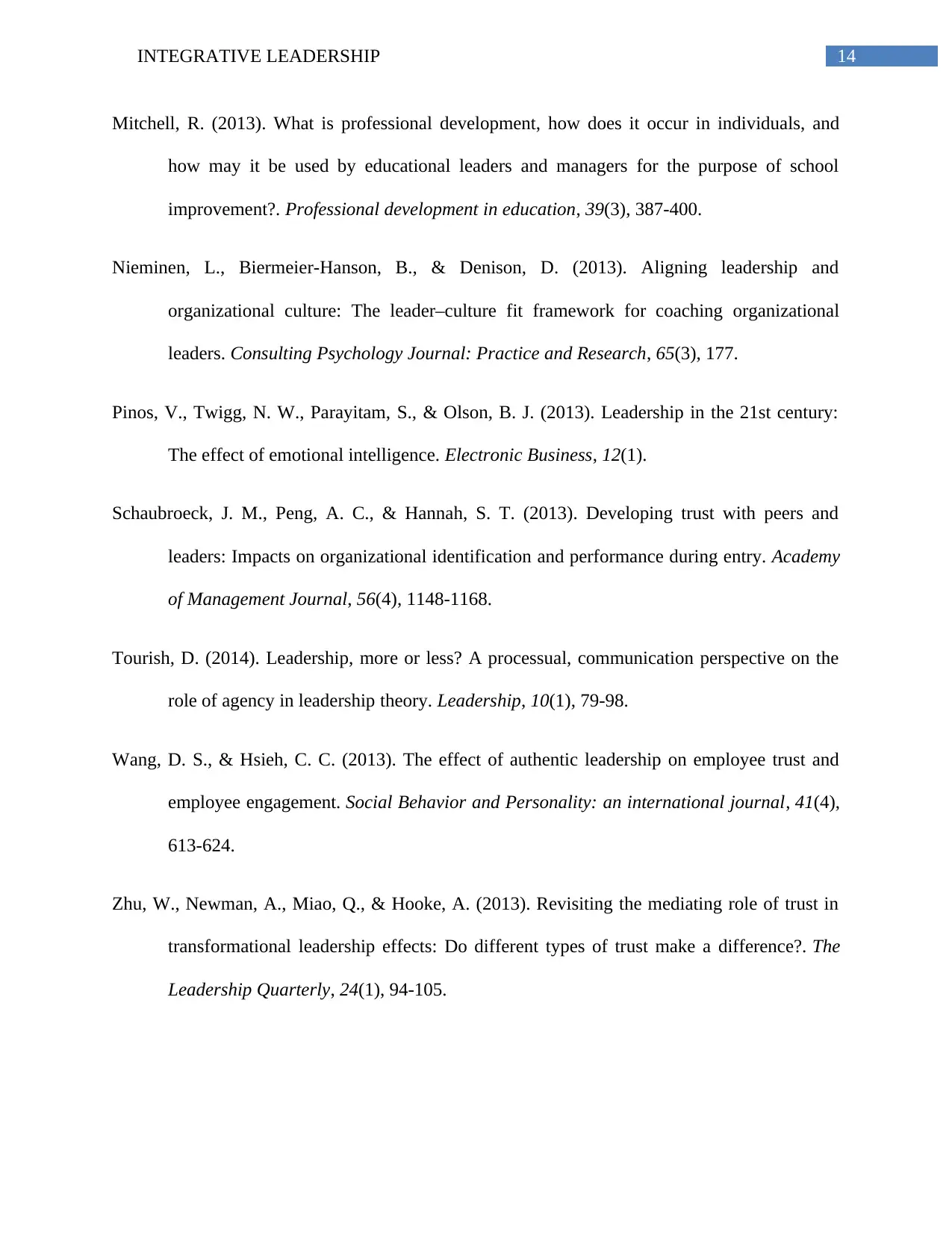
14INTEGRATIVE LEADERSHIP
Mitchell, R. (2013). What is professional development, how does it occur in individuals, and
how may it be used by educational leaders and managers for the purpose of school
improvement?. Professional development in education, 39(3), 387-400.
Nieminen, L., Biermeier-Hanson, B., & Denison, D. (2013). Aligning leadership and
organizational culture: The leader–culture fit framework for coaching organizational
leaders. Consulting Psychology Journal: Practice and Research, 65(3), 177.
Pinos, V., Twigg, N. W., Parayitam, S., & Olson, B. J. (2013). Leadership in the 21st century:
The effect of emotional intelligence. Electronic Business, 12(1).
Schaubroeck, J. M., Peng, A. C., & Hannah, S. T. (2013). Developing trust with peers and
leaders: Impacts on organizational identification and performance during entry. Academy
of Management Journal, 56(4), 1148-1168.
Tourish, D. (2014). Leadership, more or less? A processual, communication perspective on the
role of agency in leadership theory. Leadership, 10(1), 79-98.
Wang, D. S., & Hsieh, C. C. (2013). The effect of authentic leadership on employee trust and
employee engagement. Social Behavior and Personality: an international journal, 41(4),
613-624.
Zhu, W., Newman, A., Miao, Q., & Hooke, A. (2013). Revisiting the mediating role of trust in
transformational leadership effects: Do different types of trust make a difference?. The
Leadership Quarterly, 24(1), 94-105.
Mitchell, R. (2013). What is professional development, how does it occur in individuals, and
how may it be used by educational leaders and managers for the purpose of school
improvement?. Professional development in education, 39(3), 387-400.
Nieminen, L., Biermeier-Hanson, B., & Denison, D. (2013). Aligning leadership and
organizational culture: The leader–culture fit framework for coaching organizational
leaders. Consulting Psychology Journal: Practice and Research, 65(3), 177.
Pinos, V., Twigg, N. W., Parayitam, S., & Olson, B. J. (2013). Leadership in the 21st century:
The effect of emotional intelligence. Electronic Business, 12(1).
Schaubroeck, J. M., Peng, A. C., & Hannah, S. T. (2013). Developing trust with peers and
leaders: Impacts on organizational identification and performance during entry. Academy
of Management Journal, 56(4), 1148-1168.
Tourish, D. (2014). Leadership, more or less? A processual, communication perspective on the
role of agency in leadership theory. Leadership, 10(1), 79-98.
Wang, D. S., & Hsieh, C. C. (2013). The effect of authentic leadership on employee trust and
employee engagement. Social Behavior and Personality: an international journal, 41(4),
613-624.
Zhu, W., Newman, A., Miao, Q., & Hooke, A. (2013). Revisiting the mediating role of trust in
transformational leadership effects: Do different types of trust make a difference?. The
Leadership Quarterly, 24(1), 94-105.
1 out of 15
Related Documents
Your All-in-One AI-Powered Toolkit for Academic Success.
+13062052269
info@desklib.com
Available 24*7 on WhatsApp / Email
![[object Object]](/_next/static/media/star-bottom.7253800d.svg)
Unlock your academic potential
© 2024 | Zucol Services PVT LTD | All rights reserved.
